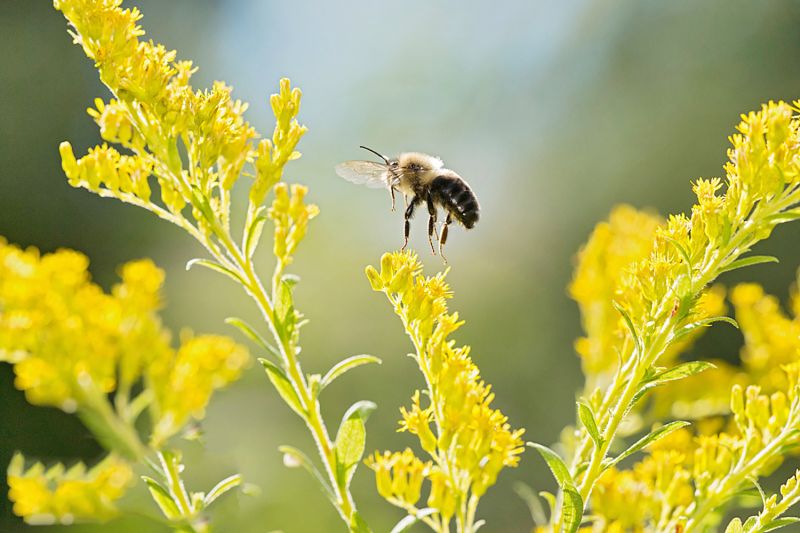Food and habitat are the most important factors in helping bees
Honeybees are making headlines lately because native populations everywhere are on a decline, a problem that affects not only the environment, but also the agricultural economy as well. As the number of native pollinators shrinks, it becomes more challenging for farmers to ensure their crops are pollinated properly. Across the United States the work pollinators do is estimated to be worth more than $14 billion each year.
However, it isn’t just the honeybees that are suffering. Denise Ellsworth, an entomologist who works with the Ohio State University’s Agricultural Research and Development Center in Wooster, said there are many other types of insects under threat (not just pollinators but also predator insects that help keep pest populations down).
“Honeybees are in the news a lot because they have a lot of specific threats, and really they are our best agricultural pollinator because we can move colonies around and bring them into fields when they need to be pollinated,” Ellsworth said. “But actually, in Ohio we have about 450 other species of bees, so we have a lot of bee diversity. These bees are vegetarians, so they are out there eating pollen and nectar to rear their young.”
Among these other varieties of bees, one in particular stands out. “The bee that is making news right now is the rusty patched bumblebee, which is a native bee,” Ellsworth said. “There are about a dozen types of bumblebees in Ohio, but the rusty patch has made the federal endangered species list because it is so threatened. It used to be a very common bee, but it hasn’t been seen much at all in the last decade.”
Researchers are working hard to find out what is causing the decline of the rusty patch bumblebee because right now all of the threats to the rusty patch and other kinds of bees have not been clearly identified. However, some threats are known.
“Habitat is definitely a problem,” Ellsworth said, “flowers and nesting spaces for bumblebees. Pesticides are always a concern. With bumblebees there are some native diseases and pests that have been introduced in the last decade or so that are really thought to be behind some of these major declines. It is really kind of a piling on of a lot of different factors that impact these bumblebees.”
So what can be done to help native populations of bees? According to Ellsworth, food and habitat are the most important factors.
“Sometimes people think that they need to learn all about these different types of bees in order to be able to help out when actually just being able to plant more food is vital. Many of our garden flowers like zinnias, marigolds, raspberries, those plants are easy to grow, and they also offer a lot for all kinds of bees to eat.”
Another way to help preserve bees and other beneficial insects is to reduce the use of pesticides or choose pesticides that have lower levels of toxicity.
“We always come to pest management from an integrated approach, so there are a lot of different options that gardeners can use to keep their plants healthy,” Ellsworth said. “It starts with picking the right plant for the right place, making sure it has good nutrition and healthy soil. All of these things work to keep plants healthy and resist insects and diseases.”
Ellsworth said if you do have a pest problem, there are other options you can use. "We can net off our pumpkins to keep squash bugs off for example.”
Ellsworth recommends against using insecticides on flowering plants because bees who visit the flowers will almost certainly pick up the toxin.
Finally there is the encouragement of beneficial predators. “Recently I was looking at some milkweed plants that had lots of aphids on them,” Ellsworth said. “But they also had lacewing larvae and ladybugs on there, the adult beetles and the larvae that all eat those aphids. If you used an insecticide on those aphids, it wouldn’t kill all those aphids, but it would kill the beneficial insects.
So sometimes it is just having the habitat in your garden so that you can have beneficial insects of all sorts. Having flowers that produce nectar and pollen, not only does it help pollinators, but it also helps to invite other beneficial insects, the predators, the good guys who are going to eat some of the pests.”
Aside from building good habitat for bees and predator insects like ladybugs and lacewing larvae, there are other ways for people to help. Ellsworth recommends checking out a citizen science project called the Ohio Bee Atlas. Anyone with a smartphone can participate.
“People can take pictures of their bees and upload them on their phones through an app called iNaturalist,” Ellsworth said. “It helps to take a snapshot across the state to see what kinds of bees we have and where they are.”
Already researchers have collected more than 2,000 images through use of this app. Experts go through and identify the bees in each of the images. So far no rusty patched bumblebees have been sighted through iNaturalist, but researchers are still gaining a wealth of information from the other types of bees being sighted around the state.
This app is not just about bees. Users can upload images of all kinds of insects for help with identification. For those who are interested, the app is available for both Apple and Android.

